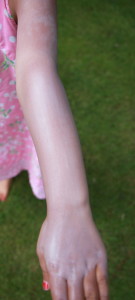 Carrying on from ‘Choosing the right sunscreen – Part 1’, I had a lot more to say about sunscreens to that particular mother in the school playground but time and children did not permit.
Carrying on from ‘Choosing the right sunscreen – Part 1’, I had a lot more to say about sunscreens to that particular mother in the school playground but time and children did not permit.
What I wanted to explain was that there are essentially two types of suncreens – chemical absorbers and reflectant or blocking sunscreens. We probably all inherently recognize the two different types.
The chemical absorbers tend to be clear and absorb into the skin whilst the reflectant or blocking sunscreens sit on the skin, leaving a white sheen or layer on the skin.
There are pros and cons to both types.
The Chemical absorbing type of sunscreen
 Chemical absorbers tend to be more cosmetically acceptable but they do allow some UVA light to get through to the skin. Also, if you suffer with eczema, the chemicals in these types of sunscreen can irritate the skin. It is therefore important to do a test patch to a small area of skin before applying it all over and also, to not rub it in too hard as it may set off a bout of itching.
Chemical absorbers tend to be more cosmetically acceptable but they do allow some UVA light to get through to the skin. Also, if you suffer with eczema, the chemicals in these types of sunscreen can irritate the skin. It is therefore important to do a test patch to a small area of skin before applying it all over and also, to not rub it in too hard as it may set off a bout of itching.
The Reflectant/Blocking type of sunscreen
 Reflectant or blocking sunscreens contain titanium dioxide which you should be able to identify in the product ingredient list on the back of the bottle. This is a mineral which sits on the skin and acts as a barrier. It works by reflecting back the UVA, UVB and infra-red rays in sunlight. As it does not penetrate the skin, it tends to be less irritating, especially if you suffer from eczema. The main drawback is the white layer left on the skin which can be quite cosmetically unacceptable particularly if you are darker skinned.
Reflectant or blocking sunscreens contain titanium dioxide which you should be able to identify in the product ingredient list on the back of the bottle. This is a mineral which sits on the skin and acts as a barrier. It works by reflecting back the UVA, UVB and infra-red rays in sunlight. As it does not penetrate the skin, it tends to be less irritating, especially if you suffer from eczema. The main drawback is the white layer left on the skin which can be quite cosmetically unacceptable particularly if you are darker skinned.
There are quite a few combination sunscreens now available which combine the best features of both types of sunscreens but again, it is important to test each sunscreen out before buying huge quantities and applying it all over, especially if you suffer with eczema.
Also, sunscreens can be expensive if you are putting them on every day in the correct quantities and frequency of application. It is still important to remember that a sunscreen does not mean that you can stay out in the sun for longer than you normally would but that it is a form of protection against sun damage whilst you are in the sun.
Sandy
Dr Sandy Flann, Consultant Dermatologist
